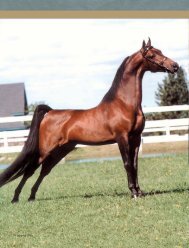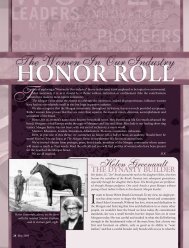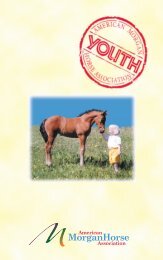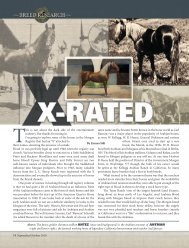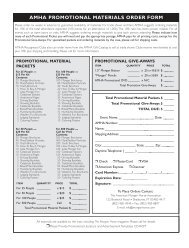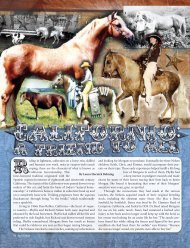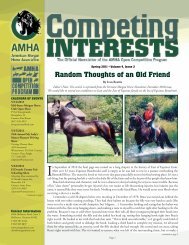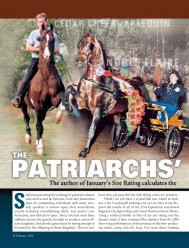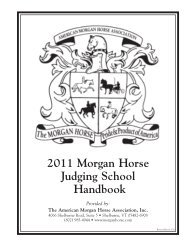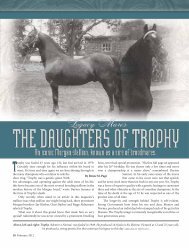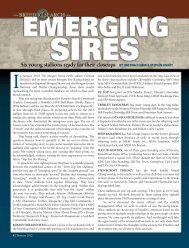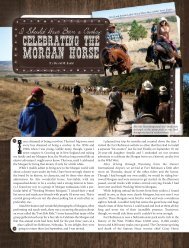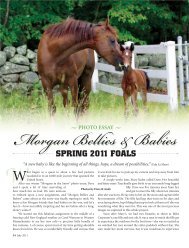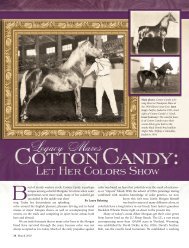Create successful ePaper yourself
Turn your PDF publications into a flip-book with our unique Google optimized e-Paper software.
u <strong>Breeders</strong> Roundtable u<br />
<strong>Boutique</strong><br />
<strong>Breeders</strong><br />
By Abbie Trexler<br />
Robin Herrick,<br />
Cherrydale Manor<br />
New Wilmington,<br />
Pennsylvania<br />
Anne Wyland,<br />
Ancan Morgans<br />
Davison,<br />
Michigan<br />
Laura Braddock,<br />
LBJ Morgans<br />
Spencer,<br />
Ohio<br />
Susan Carlino,<br />
Silver Creek Farm<br />
San Martin,<br />
California<br />
Jay Kleiber,<br />
Ridgewood Farm<br />
Elizabeth,<br />
Colorado<br />
(Photo © Caprice Soltice)<br />
The state of the equine economy has caused most breeders to downsize the number of foals they produce each<br />
year: for the time being, supply has responded to lower demand. Some breeders, however, have long been small<br />
breeders by choice. Regardless of the disciplines for which they’ve bred, they’ve kept numbers low.<br />
This permits them to develop a plan for every foal, regardless of the vagaries of the marketplace.<br />
We’ve termed them “boutique breeders.” Sit in as this group chats about the economy, their breeding<br />
philosophies, evaluation of stock, marketing and what lies ahead for them.<br />
Tell us about your program: What is the size of your breeding<br />
operation Do you own your own stallion How many mares<br />
do you own How many foals do you have a year<br />
Robin Herrick: We generally have eight to ten mares actively in the<br />
breeding program. I am currently on an every-other-year rotation<br />
with them so we produce three to five foals per year. Because all of<br />
our youngsters leave the farm to obtain “higher education,” I find<br />
this to be a more manageable number when they reach that age. I<br />
currently do not stand a stallion. It has been my experience that<br />
the vast majority of studs in our breed are very available through<br />
the generosity of the stallion owners. The stallion owners are, of<br />
course, a huge part of our industry but with a smaller operation<br />
the choices are much greater breeding to a variety of studs rather<br />
than standing one of my own. That being said, the total cost of<br />
producing a foal can be substantially more using that approach. I<br />
like my total number of horses to be under 25.<br />
Anne Wyland: I began my breeding program in the early 1990s.<br />
Presently, I have 29 Morgans, although that includes five which<br />
are boarded here and another who is on lease for breeding. Of my<br />
own 23 horses, I have 14 mares of breeding age, and two others<br />
that will mature into my program someday. I own and stand my<br />
own stallion but breed to outside stallions occasionally, too. I<br />
am expecting five foals in 2011 and that number is up from the<br />
previous two years. Five or six mares will be bred for 2012 foals. I<br />
have raised as many as 10-12 foals a year, but that was in the ’90s<br />
and early 2000s.<br />
Laura Braddock: Our first foal was born in 1999 and at that time<br />
we had three Morgans. Currently we have 12 horses; two stallions,<br />
six broodmares and our sale stock which consists of a four-yearold<br />
Western mare, a three-year-old pleasure driving mare, a twoyear-old<br />
gelding, and a yearling filly. We are expecting only one<br />
foal for 2011 and plan to breed three mares this year. We normally<br />
breed between two and three mares per year.<br />
Susan Carlino: Silver Creek Stables is a small five-acre farm<br />
located in San Martin, Ca. Owned by my mother, Lorraine Bumb<br />
and I, we breed, raise, show and sell good Morgan horses. As most<br />
82 April 2011
BREEDERS ROUNDTABLE: The <strong>Boutique</strong> <strong>Breeders</strong><br />
breeding programs are based on the stallion, our program is based<br />
on the bloodlines of one great mare, Fletcher Music Lee. And from<br />
her daughters, GLB Bell Of The Ball (by HVK Bell Flaire), GLB<br />
Perfect Harmony (by Futurity French Command), GLB Grand<br />
And Glorious (by HVK Bell Flaire), GLB Moonlight Sonata (by<br />
Liberation First Star), and GLB Like Nobody’s Byz (by Stonecroft<br />
Byzantine), her legacy lives on in the tradition of producing great<br />
Morgans that are pretty, sound, sane show horses that have the<br />
heart and desire not only to compete, but to win!<br />
We do not own our own stallion. There are so many proven<br />
stallions available that we feel it’s easier and less expensive in<br />
the long-run to take advantage of the great bloodlines available<br />
through frozen and fresh cooled semen. We usually have between<br />
two and four foals each year, of which one or two are embryo<br />
transfers. This way we are able to continue to show and promote<br />
our great mares throughout the year. <br />
Jay Kleiber: Ridgewood Farm is a small, 25-acre farm located in<br />
the southeast Denver area. We maintain a select group of mares,<br />
typically around ten. We do not own a breeding stallion at this time.<br />
In the past we have bred as many as 14 foals per year; however, with<br />
the economy as it is we have tailored our program, cutting back<br />
significantly on the number we breed.<br />
Do you do this all on your own, as a family or does it<br />
require staff<br />
Robin Herrick: It would be impossible for Neil and I to practice<br />
medicine full time and not have an amazing support structure.<br />
From the trainers that prepare and campaign the show stock—<br />
including those that have gone on to new owners and are no<br />
longer owned by Cherrydale—to the dedicated veterinary and<br />
reproductive staff, to the great people who stay at home and care<br />
for everyone as if they were their very own, enabling Neil and I to<br />
travel and enjoy the shows and the “fruits of our labor.” We need<br />
and are very thankful for them all!<br />
Anne Wyland: Since the horses are my passion and not that of<br />
my family, I do a lot of the work myself. I have two college aged<br />
“barn girls” who help out by doing evening chores on a part-time<br />
basis. My son works for me part-time cleaning stalls, putting hay<br />
up in the loft, and in other miscellaneous ways as needed and when<br />
available. It’s the same with my husband. My husband likes the<br />
horses, just not the work that comes with them and that’s usually<br />
the only time he complains...It seems there is always a broken<br />
board to repair or something else that needs fixed; and he is good<br />
about helping out when I need it. I think my son and my husband<br />
would both cheer if the day ever came when I said, “Let’s sell all the<br />
horses,” but that isn’t going to happen.<br />
Laura Braddock: Our breeding program is managed by my<br />
husband, Jim, and myself. Jim is mostly responsible for handling<br />
the day-to-day tasks from feeding, cleaning the stalls to the pasture<br />
management and, of course, spoiling the new foals. I handle the<br />
vet and blacksmith care, choosing the stallions, breeding and<br />
working with the foals. The training and showing responsibilities<br />
are handled by Tim Roesink of Grove Pointe Stables.<br />
Susan Carlino: No matter the size of your operation those you<br />
work with are your family whether they are related to you or not.<br />
Ours could definitely be classified as a family operation. With my<br />
mom at the helm, I manage and make sure everything gets done at<br />
the right time, our daughter Jessica is the go-to gal—if you need<br />
something done she is the one who makes it happen. My husband,<br />
Dan and son, Daniel, are the voices of reason and keep us grounded<br />
in reality. Along with Jessica, our other daughters, Anna, Elise<br />
and Genevieve are the research specialists, catch riders/drivers,<br />
emergency farm EMTs, bag ladies for photo and video shoots, and<br />
good old fashioned comic relief.<br />
And we wouldn’t be able to pull it all together without such<br />
a gifted trainer as Cathy (Grimes) and our one full-time and two<br />
part-time maintenance guys who are specialists at keeping all our<br />
horses happy and the farm safe and beautiful.<br />
Jay Kleiber: Ours is a family operation, but we do have staff that<br />
does the feeding and cleaning twice daily. They also ensure the<br />
horses are all okay in the fields, clean stock tanks and tend to the<br />
overall maintenance of the farm. Julie oversees the staff on a daily<br />
basis and is in the barn every morning before she leaves for work.<br />
She is very much a hands-on manager.<br />
Has the economic downturn affected how many of your<br />
mares you breed each year<br />
Robin Herrick: Of course!! As a breeder, we tread a fine line in<br />
regards to numbers. We must have quality stock available to the<br />
public at various levels of training to keep ourselves marketable<br />
but be cautious as to not become “overstocked” and not do justice<br />
to each individual animal.<br />
Anne Wyland: Absolutely. I have reduced the number by half to<br />
two thirds. I’m a little concerned about having five foals arrive this<br />
year and I’m hoping the market will support fair sales for them.<br />
I’m prepared to keep them until they are trained and wearing<br />
leather if it doesn’t. I’ve already decided that if the market hasn’t<br />
improved by spring of 2012, I will not breed anymore foals until all<br />
my youngsters have sold.<br />
Laura Braddock: Fortunately, we went into the economic<br />
downturn with only a few Morgans to sell and the young stock we<br />
have today for sale already hold impressive in-hand titles and are<br />
currently continuing their performance training at Grove Pointe.<br />
Therefore, we have continued to breed two to three mares each<br />
year and only keeping and investing in the exceptional foals for<br />
future sale stock.<br />
Susan Carlino: Maybe a little bit. Between the economy and the<br />
small size of our farm we have to make sure that all the horses on<br />
the farm have a job. Those who don’t have jobs are hard to find<br />
homes for so we try to make sure our crystal ball is polished and in<br />
good working order when we plan each year’s breedings.<br />
Jay Kleiber: The economy has had a significant impact on our<br />
breeding program. Prior to the downturn, we were able to market<br />
and sell weanlings and yearlings as fast as we could produce them.<br />
Our program was directed toward speculation buyers and we were<br />
very successful, with our clients buying young stock from us and<br />
going on to win Grand National and World Championships with<br />
them. Since then, the market demand has changed significantly. It is<br />
difficult to sell horses that are not wearing leather and, necessarily,<br />
we have had to tailor our approach to the changing market. We<br />
The Morgan Horse 83
BREEDERS ROUNDTABLE: The <strong>Boutique</strong> <strong>Breeders</strong><br />
breed fewer mares now and need to direct our resources toward<br />
having our Morgans in training in order to market them. Since<br />
Julie and I do not train ourselves, it is a significant change in how<br />
we funnel resources. As responsible breeders, we have reduced our<br />
total herd count from our peak of 48 down to 17. Our plan is to<br />
continue to reduce our numbers and not breed more than one to<br />
three foals per year. In this market, even that may be unrealistic.<br />
How did you evaluate your broodmares<br />
Robin Herrick: I have found most success with retaining<br />
daughters of mares that have been exceptionally good producers<br />
for me. I like to give them the opportunity to be bred to several<br />
different stallions before I make a decision as to them staying in<br />
our program long-term. I then select an occasional individual to<br />
purchase that would best complement our bloodlines. The very<br />
best mares consistently produce better than themselves when bred<br />
to multiple different stallions.<br />
Anne Wyland: For those who have given me foals in the past, I<br />
evaluate them based upon their production records. For new<br />
mares just entering my program, I evaluate them based upon<br />
pedigree, conformation (and form for function), disposition, and<br />
past production records if available. When I buy or lease a mare,<br />
I’m looking for specific traits to compliment the stallion I have in<br />
mind for them.<br />
Laura Braddock: I have invested a lot of time in the decision process<br />
when it came to the broodmares. Our broodmares possess some<br />
very grand old bloodlines which enable us to breed them to the<br />
more popular bloodlines sought after in our breed today, creating<br />
a small ear, pretty headed animal with the size and athletic ability<br />
that is consistently dominating the winners circle. Our mares have<br />
good size and substance which make them good broodmares with<br />
very few foaling problems. We have bred some of our mares for<br />
the soul purpose of creating our own breeding stock, which has<br />
proven to be a good decision for us.<br />
Susan Carlino: We have a very high opinion of all our mares. They<br />
are beautiful, talented, have tremendous bloodlines and, most of<br />
all, are true and gifted athletes with the charisma and charm to do<br />
well in the show ring. And, most of all, they give us foals that easily<br />
carry on in the tradition of their great parents and grandparents.<br />
Jay Kleiber: We tend to be in constant upgrade mode. Our goal is<br />
to continuously improve our herd quality as opportunities present<br />
themselves. We try to select the very best mares we can afford at<br />
the time and do our best to breed them wisely. Both bloodlines<br />
and individual conformation traits are evaluated. Specifically, we<br />
like to see a great shoulder on a mare, though this is a very elusive<br />
trait. Tight, refined ears are very important to us as are big eyes.<br />
They both bring an overall quality to the look of a mare. More<br />
and more size is becoming a factor and while we recognize this as<br />
breeders, most of our mares are 15 hands or smaller. Long front<br />
legs, regardless of size, are also very important to us. We’ve valued<br />
strong powerful hocks in our program and have been able to keep<br />
this trait primarily by utilizing the Serenity Masterpiece blood<br />
both in our mares and in some of the stallions we have used for<br />
our mares. We are in the minority in believing there is such a thing<br />
as a neck that is too long. We are also in the minority in believing<br />
if you have to make a compromise, it should be the topline before<br />
it is the shoulder. Despite the varied bloodlines, if you were to<br />
walk our fields you would find our mares are all very consistent.<br />
Beautiful, refined, mid-sized with strong bodies, medium length<br />
necks, strong hocks and good shoulders.<br />
What thought process do you go through when choosing<br />
matings<br />
Robin Herrick: I begin early in the spring (after the foal crop is<br />
safely here) to plan for the next year. I begin with a short list being<br />
very critical of what I view as my mares’ biggest shortcomings (they<br />
all have them!). I have a list of options in mind…usually three to<br />
five stallions that I feel would be a good cross. I find the AMHA<br />
online access to be a wonderful tool to research bloodlines. I try to<br />
choose the cross that would best complement my mare on paper<br />
and still be very strong phenotypically where she may not be as<br />
much so. Finally, as the list becomes even shorter, I do put some<br />
consideration into the breeding contract and the availability of<br />
the stallion…where he is standing, how many days a week semen<br />
is available, etc.<br />
Anne Wyland: I can’t look at a mare—any Morgan mare—and<br />
not size her up for breeding quality. It’s almost second nature<br />
to me anymore. I’m not sure that is a good thing, but it’s how<br />
my mind works. Until the market really comes back with a<br />
demand for young stock again, I’m basically looking to use my<br />
own stallion. So, when considering mares for him, I’m looking to<br />
create a “marketable” result. I tend to stick with the tried-n-true<br />
crosses of the past, and if a new mare comes in to my program,<br />
I look at her phenotype. Does it compliment that of my stallion,<br />
and visa versa<br />
I did purchase outside stallion services this year and I haven’t<br />
done that in several years. I try to always stay within a certain<br />
bloodline or two. I do that because I’m familiar with it; the pros<br />
and the cons. Then I looked for traits in stallions (and their blend<br />
of bloodlines) that would best compliment my mares. For instance,<br />
if the mare needs a better tip-over at the poll, but has outstanding<br />
use of her hocks, I’ll look for a mate whose lines are known for<br />
a good tip at the poll. If the stallion doesn’t have the best hock<br />
action I want but it’s acceptable, I’ll still consider him for the “fix”<br />
at the poll and count on the mare to improve his hocks. Breeding is<br />
always a gamble, but when you make it an educated guess, it works<br />
more often than not.<br />
Laura Braddock: I try to find the best stallion to complement<br />
and improve over my mares, I put a lot of weight on the stallion’s<br />
performance ability as well as his current offspring and what<br />
characteristics he passes on to them. Tim Roesink is especially<br />
helpful in this area, he has a lot of knowledge and expertise, his<br />
guidance has been an important part of my breeding process as<br />
well as its success.<br />
Susan Carlino: Breed the best to the best. We know what our<br />
mares will produce. Evaluating the stallion is more of a process.<br />
Show record, consistency in what they produce and how they are<br />
as individuals all go in to deciding which stallions to breed to<br />
our mares.<br />
Jay Kleiber: Several factors come into play when choosing stallions<br />
84 April 2011
BREEDERS ROUNDTABLE: The <strong>Boutique</strong> <strong>Breeders</strong><br />
for our mares. Phenotype and genotype considerations both enter<br />
the decision-making process. While we revere bloodlines, in the<br />
final analysis you’ve got to look at the mare standing in front of<br />
you prior to selecting a stallion. Of course there is always that plain<br />
Jane mare that turns out to be a top producer, but they are the<br />
exception. We look at crosses that have proven to be successful for<br />
other breeders and we consider the prepotency of the stallion. We<br />
also rely on input from others in the industry we respect, including<br />
Ann Hailey, Iann Fu-Longenecker, Renee Page, Debi Boies and Ken<br />
Martin. Each of these people has been a willing sounding board<br />
for us when making breeding decisions and their input has been<br />
invaluable. Having someone you can rely on for candid feedback is<br />
so important in this process. More and more, we are leaning toward<br />
using only stallions that are proven in the industry and have breed<br />
caché, but we do, on occasion, select a young unproven stallion for<br />
one of our mares. Lastly, gut instinct plays no small role when we<br />
make our decisions. The World Champion Mare, RWF Over The<br />
Rainbow, was a gut instinct breeding. We never underestimate the<br />
power of the little voice within.<br />
How do you judge the foals you produce and do you make<br />
a marketing plan for each of them<br />
Robin Herrick: Because we produce only a few foals each year, we<br />
strive to make sure each one becomes the best they can be. All of<br />
the foals grow up here…at least until they are long yearlings and<br />
sometimes until they are two before they go off for training. That<br />
gives one a lot of insight as to what we think they may be and what<br />
division they would excel in. We then rely on the trainers to bring<br />
those qualities to the forefront. Most buyers are shopping for a<br />
specific division and their decision is much simpler when they can<br />
envision that individual in their respective divisions. We formulate<br />
our marketing plan based on where each individual is best suited.<br />
Anne Wyland: We take pictures of our stock all the time. In<br />
fact, through the summer months, as the foals are growing and<br />
maturing, we take photographs and video of them almost every<br />
weekend. Sitting back and studying video and still photography<br />
really helps you critique the individual. I like the expression, “judge<br />
the foal at two weeks, two months, and two years.” I do that and<br />
price it accordingly.<br />
Every foal has a marketing plan. I use the Internet and my<br />
website predominantly as my source of marketing, but advertise<br />
in Morgan periodicals from time to time as well. In February, I<br />
announced my 2012 breeding plans on my website and have<br />
received feedback from visitors on those plans already. I have<br />
people eager to see foals who aren’t even conceived yet, and have<br />
already had interest from prospective buyers on some of them.<br />
Laura Braddock: We start our foal’s showing careers as early as<br />
three months therefore we start evaluating them at about a month<br />
old. I normally have them entered in one or two sweepstakes as<br />
weanlings and two or three sweepstakes as yearlings. We show<br />
them accordingly depending on their individual development or<br />
make a decision to sell them early before investing in their future.<br />
Susan Carlino: We love each of our foals and think very highly of<br />
them all. Usually by the end of their yearling year when they are<br />
brought in, cleaned up and put to work we have a pretty good idea<br />
of what they want to do and Cathy is so good at bringing out the<br />
best in each one. Our marketing plan is flexible and we tailor it to<br />
fit each individual.<br />
Jay Kleiber: As small breeders we have had to make quick decisions<br />
about our foals in the past. Julie will sometimes get frustrated with<br />
me because I’ll pass judgment on a foal too quickly. It’s probably<br />
the one area where we tend to disagree consistently. I believe you<br />
can get a very good feel for the quality of a foal when it is very<br />
young, say three weeks. Julie often prefers to wait until three years.<br />
The problem with Julie’s approach is that it’s very costly to keep a<br />
foal until it is three years old; only to find out is it not going to be<br />
a top caliber show horse. I would prefer to make that decision at<br />
a much younger age and take my lumps when I find I’ve sold one<br />
short in the process. We do not make a marketing plan for each of<br />
our foals. We tend to let them tell us what they want to be and often<br />
that takes time. This tends to tip the balance in Julie’s favor.<br />
How do you market and promote your breeding program<br />
What is your target market<br />
Robin Herrick: Most of our horses are targeted toward the show<br />
horse market. We do a fair amount of advertising in all of the<br />
publications and certainly get a lot of inquiries based on what<br />
we may have out showing that people can see. The internet is a<br />
wonderful tool but I do admit difficulty finding time to update<br />
websites! I also like to have one or two in the barn that can be true<br />
ambassadors to the breed and perhaps be marketed to an owner<br />
that may never have experienced the joy of owning Morgan horses!<br />
Anne Wyland: Well, my target market has changed in the past few<br />
years and I feel it’s a result of the overall economy. I used to breed<br />
for show, and now I try my best to breed “show quality” horses that<br />
buyers can use at home and safely enjoy on trails. I find that people<br />
still want “show quality” but they would rather take that nice horse<br />
down a relaxing country trail than down the tanbark of a high end<br />
horse show.<br />
I have branched out in my circle of “where” I market and<br />
always try to advertise available horses in venues where John Q<br />
Public can find them. Those who may not have a Morgan or aren’t<br />
active in the Morgan clubs across the nation aren’t necessarily privy<br />
to all our club magazines, newsletters, and networking circles. They<br />
don’t know about some of our all-Morgan advertising venues—so<br />
I try to place ads in all breed areas so those searching for their first<br />
Morgan can find me there.<br />
Then I always try to mention the “show quality” but safe and<br />
sane for use at home—because I feel that is what most buyers are<br />
looking for.<br />
Laura Braddock: We have a website that we use to inform interested<br />
parties as to what stallions our mares are bred to, pictures of the<br />
breeding stock as well as the offspring and their accomplishments,<br />
picture pages and sales pages. I like to run a few ads in the breed<br />
magazine including not only show stock, but also the younger<br />
stock for sale. Our foals are shown very young and, fortunately for<br />
us, they have been pretty successful. I feel that my target market is<br />
probably three- to five-year-old stock selling a few younger horses<br />
from time to time.<br />
Susan Carlino: First and foremost you need to have a good product<br />
86 April 2011
BREEDERS ROUNDTABLE: The <strong>Boutique</strong> <strong>Breeders</strong><br />
to offer—one that is pretty, sound, correct and that has the heart,<br />
desire and charisma to excel at their given task.<br />
Next would be to have a good show record. And nobody<br />
will know about that if there is no advertising to tell the world<br />
about what you have to offer. Print ads in TMH magazine, show<br />
programs and other trade magazines keep your product fresh in<br />
everyone’s minds. And, in this age of the electronic super-highway,<br />
websites are one of the greatest tools available to breeders. A good<br />
website that is easy to find and to navigate, that has all pertinent<br />
information available at a glance with good photos and video<br />
that are updated on a regular basis will bring the world to your<br />
front door. A bad website can do the opposite if the information<br />
and photos are of poor quality and out of date. See some good<br />
examples at www.CarlinoWebServices.com<br />
Jay Kleiber: We have a comprehensive website available as a<br />
promotional too. We also use trainers, personal networking, social<br />
networking (Facebook) and breed publications. Our target market<br />
is the show horse market.<br />
What are your plans for 2011 and beyond<br />
Robin Herrick: We are expecting three foals in 2011 and have<br />
plans underway to breed four mares for 2012. We have a number<br />
of youngsters to be very excited about and look forward to them<br />
growing up to be the very best they can be!<br />
Anne Wyland: With the overall soft market for sales that we have<br />
experienced the past four or five years, it’s really hard to project<br />
more than a year or two in to the future. <strong>Breeders</strong> need to keep<br />
abreast of the market, wait and see how it turns out, then breed<br />
accordingly. I’m optimistic. The ball has to hit the floor before it<br />
can bounce back up again, and I think that’s where we are today.<br />
I think 2012 will bring a change where the supply and demand is<br />
much more even than it’s been in the past. But I will wait to see that<br />
happen before I make any concrete breeding decisions.<br />
Laura Braddock: I feel that the economy will be on a gradual<br />
upswing beginning this year, however the recovery of our industry<br />
will be slower than other parts of our economy. My goal is to make<br />
available as the market recovers a nice selection of young broke<br />
Morgans for the amateur market as well as some, young stock for<br />
the buyer wanting to make an investment in our breed, keeping the<br />
quality and quantity of our stock manageable.<br />
Susan Carlino: To breed great Morgan horses and to see the next<br />
generations of riders, drivers and great Morgans trot in to the<br />
winner’s circle and on to the pages of Morgan history.<br />
Jay Kleiber: For 2011, we are excited to have leased RWF Over<br />
The Rainbow from Copper Beech LLC to breed in 2011. We are<br />
currently in the process of selecting the right stallion. I’ll be calling<br />
on my confidants, for sure, and listening to my gut, of course.<br />
Much is to be learned about the future of the industry. Our plans<br />
are to scale back significantly while riding the economic downturn<br />
wave. We do not have confidence we will ever return to the glory<br />
days we enjoyed over the last decade but we are confident the breed<br />
is here to stay. And so is Ridgewood Farm. n<br />
To get that big smile like<br />
Tracy Hall-Britt’s:<br />
Start with a good young foal like<br />
Whippoorwill Coronet<br />
(Whippoorwill King Jubilee x<br />
Whippoorwill Corona);<br />
Work with a friend,<br />
trainer/instructor like Heidi Lucas;<br />
Take an active part in every stage of<br />
his training<br />
And before you know it you have<br />
the thrill of riding that very special<br />
Morgan, all your own!<br />
McCulloch Farm ~ Whippoorwill Morgans<br />
Since 1945<br />
100 Whippoorwill Road, Old Lyme, CT 06371 • Mary Jean & Christ Vasiloff<br />
(860) 434-7355 • mjvasiloff@earthlink.net • www.whippoorwillmorgans.com<br />
88 April 2011



